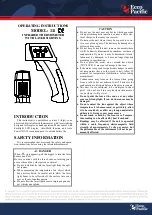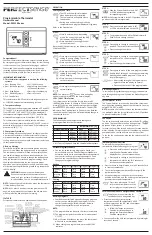
Appendix: How Infrared Thermometry Works
A
A-4
Optics Field of View
Accurate measurement of temperature via infrared means depends
strongly on the size of the object and the distance between the
thermometer and the object. All optical devices (e.g. cameras,
microscopes, infrared thermometers) have an angle of vision,
known as a field of view or FOV, within which they see all objects.
In particular, the thermometer will measure a fixed proportion of
the energy radiated by all objects within its FOV. The user must
guarantee that the distance between the thermometer and the object
is defined so that only that object fills the FOV of the instrument.
Referring to Figure A-3, Objects “X” and “Y” are within the FOV of
the thermometer. The measured temperature would fall somewhere
between the actual temperatures of the two objects. In order to
measure the temperature of Object “X” accurately, Object “Y”
would need to be removed. In order to measure the temperature of
Object “Y” accurately, the user would need to move closer to Object
“Y” until it completely filled the FOV of the thermometer.
Alternatively, the user could measure the temperature of Object “Y”
with a thermometer with a smaller FOV.
Figure A-3. Field of View of a Thermometer
The distance-to-spot size ratio (
D
⁄
S
) defines the field of view (FOV).
Thus, a
D
⁄
S
= 10 gives you approximately a 1 foot spot size at a
distance of 10 feet. For accurate spot size values, refer to the Field of
View diagrams shown in Figures 2-4 through 2-6.
SPOT
SIZE
DISTANCE
FOV
ANGLE
OBJECT "Y"
OBJECT "X"
Summary of Contents for OMEGASCOPE OS520
Page 4: ...ii Unpacking Instructions This page is intentionally blank ...
Page 7: ...v TABLE OF CONTENTS ...
Page 13: ...General Description 1 1 6 Notes ...
Page 49: ...4 3 Sighting Scope 4 Notes ...
Page 57: ...Troubleshooting Guide 6 6 6 Notes ...
Page 63: ...Glossary of Key Strokes 8 8 2 Notes ...
Page 73: ...Appendix Determining an Unknown Emissivity C C 4 Notes ...
Page 77: ...I 4 Index I Notes ...













































